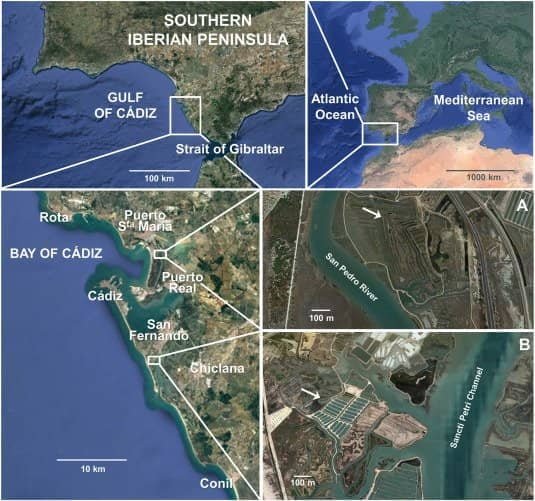
Aquaculture has become the primary alternative to overcome overfishing and ensure food security for the global population.
Given that mariculture often entails environmental impact, the development of sustainable marine aquaculture is a priority. This way, marshes can provide ecosystem services and incorporate both conservation and intensive aquaculture activities.
Researchers from the universities of Seville, Cádiz, and Huelva, in collaboration with scientists from the Mediterranean Institute for Advanced Studies (CSIC), have conducted a study that highlights the significance of the estuaries of the Bay of Cádiz for the ecological cultivation of fish, such as the gilthead seabream (Sparus aurata).
The study, published in the prestigious journal Marine Environmental Research and led by José Manuel Guerra García, professor in the Department of Zoology at the Faculty of Biology, University of Seville, reveals that gilthead seabream cultivated in the estuaries of the Bay of Cádiz show many similarities with wild gilthead seabream.
The researchers compared the cultivation of gilthead seabream (Sparus aurata) in extensive and semi-intensive ponds with their wild counterparts from surrounding coastal areas, using trophic characterization and trace metal accumulation.
Aquaculture: A Practice to Secure the Future of Fish and Seafood
According to the Food and Agriculture Organization of the United Nations (FAO), aquaculture is an activity aimed at producing and fattening aquatic organisms in their environment. It is also defined as the controlled cultivation of species that develop in aquatic environments (fish, mollusks, crustaceans, and algae) and are useful for humans. Thus, the marine environment can become an excellent area for exploiting natural resources.
Aquaculture is booming and will ensure the future consumption of fish and seafood on a planet where fishery resources are overexploited.
Given the growing importance of this sector, national and international directives aim to achieve increasingly environmentally sustainable farming practices. In this sense, researchers propose estuaries as high-value ecological ecosystems suitable for carrying out respectful and conservation-compatible cultivation.
Stay Always Informed
Join our communities to instantly receive the most important news, reports, and analysis from the aquaculture industry.
In estuaries, fish thrive in a suitable environment and can feed on small invertebrates, mainly crustaceans, that naturally grow in the estuary.
A Study Focused on the Diet of Gilthead Seabream
The scientists’ work has focused on trophic characterization of fish diets (through the study of prey found in stomach contents and rigorous stable isotope analysis) and quantification of heavy metal concentrations in gilthead seabream specimens (Sparus aurata).
The results show that in extensive estuaries, the diet of gilthead seabream is very rich, especially in decapod crustaceans, and the isotopic profile has a high trophic breadth and is similar to that obtained for wild gilthead seabream from the Bay of Cádiz. Furthermore, the heavy metal concentrations in fish from the estuaries are below the legal limits set by national and international regulations, ensuring safe consumption.
Cádiz Estuaries: The Ideal Home for Fish
The estuaries, salt pans, and marshes of the Bay of Cádiz are natural spaces that represent some of the most important coastal wetlands in Europe. These ecosystems reflect a blend of tradition, gastronomy, and conservation of flora and fauna, making them optimal sites for responsibly developing fish farming in harmony with the environment. The development of quality labels, such as the ‘Estuary Fish’ brand, is necessary to promote this product.
Scientists like José Manuel Guerra emphasize the need for competent authorities to recognize the importance of estuaries. This awareness is crucial not only to prevent their disappearance but also to make them a significant source of economic resources for the region through high-quality fish production.
Moreover, estuaries can serve as an interesting example of Integrated Multi-Trophic Aquaculture (IMTA) systems, combining extensive fish and amphipod crustacean cultivation associated with marsh ponds.
Conclusion
According to the researchers, despite differences in diet and isotopic space, the study “revealed that extensively cultivated gilthead seabream in estuary ponds showed similarities with their counterparts captured in the wild in terms of trophic characteristics and concentrations of trace elements in muscle tissue samples.”
They also conclude that the extensive and semi-intensive use of estuaries offers a promising environment for aquaculture activities. “In particular, the extensive system provides a fish product similar to their wild counterparts, with similar characteristics in the trophic niche and trace metal concentrations below legal limits.”
Finally, they highlight that marsh ponds, especially extensive ones, should be promoted as environmentally sustainable ecosystems to contribute to diversifying aquaculture products.
The study was funded by the Ministry of Science, Innovation, and Universities, co-funded by the State Research Agency (AEI) and the European Regional Development Fund (ERDF).
Reference (open access)
Guerra-García, J. M., Calero-Cano, S., Donázar-Aramendía, I., Giráldez, I., Morales, E., Arechavala-Lopez, P., & Cervera-Currado, J. L. (2023). Farming Sparus aurata (Teleostei: Sparidae) in marsh ponds: Trophic characterization and trace metal accumulation. Marine Environmental Research, 106007.
Editor at the digital magazine AquaHoy. He holds a degree in Aquaculture Biology from the National University of Santa (UNS) and a Master’s degree in Science and Innovation Management from the Polytechnic University of Valencia, with postgraduate diplomas in Business Innovation and Innovation Management. He possesses extensive experience in the aquaculture and fisheries sector, having led the Fisheries Innovation Unit of the National Program for Innovation in Fisheries and Aquaculture (PNIPA). He has served as a senior consultant in technology watch, an innovation project formulator and advisor, and a lecturer at UNS. He is a member of the Peruvian College of Biologists and was recognized by the World Aquaculture Society (WAS) in 2016 for his contribution to aquaculture.




